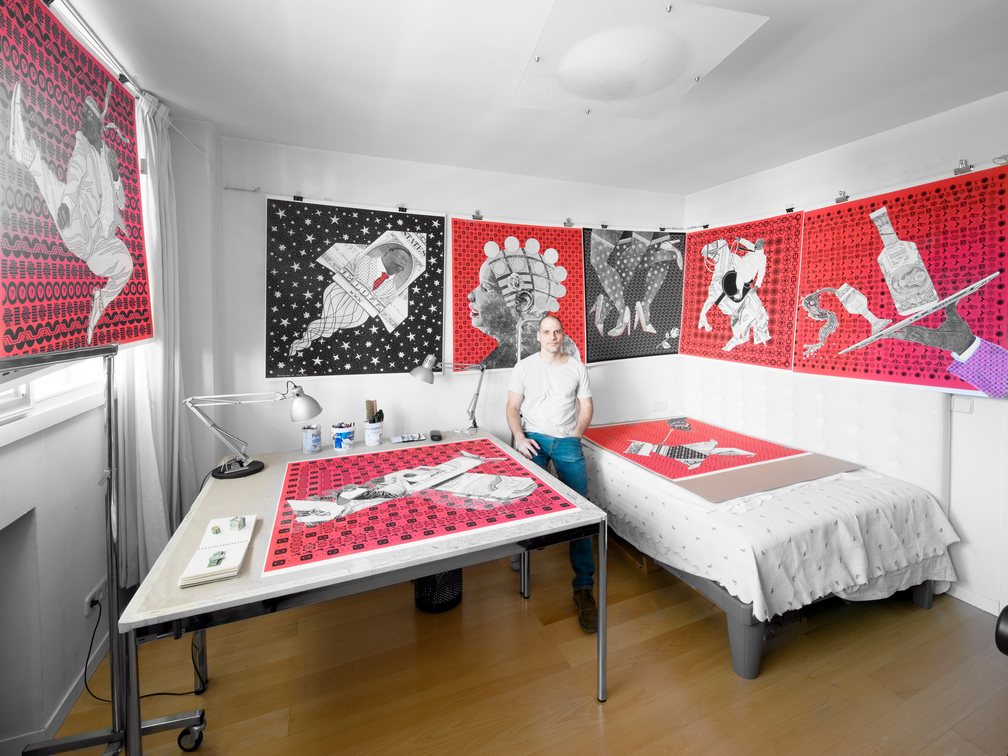Museo delle Culture uses cookies to improve the user experience. If you need more information click on the privacy page. Privacy policy X
29 June 2023 - 05 November 2023, VILLA MALPENSATA, SPAZIO CIELO
The exhibition, the second appointment of MUSEC's Global Aesthetics project, presents some of the most recent series by Filipe Branquinho (Maputo, Mozambique, 1977), a Mozambican artist and one of the most authoritative, lucid and desecrating voices in African art.
The MUSEC exhibition, curated by Kristian Khachatourian and Lidija Kostic Khachatourian, presents around 30 large-scale works (mixed media on cotton paper and photographs) created between 2019 and 2022, in which Branquinho investigates social themes, popular customs, mythologies and urban dynamics of his country. His works, which combine tradition and contemporaneity, are shot through with a touch of humour and a keen sense for satire, as a strategy to bring to light the intertwined values and contradictions of Mozambique and common to other African countries. With his art, Branquinho aims to create a space in which social criticism, never an end in itself, contributes to the debate to improve the quality of life and the future of an entire community. Branquinho's figurative universe often includes the traditional Mapiko masks of the Makonde, an ethnic group widespread in northern Mozambique. The artist uses the masks as caricatures to narrate real facts and people, as they were also sometimes used in the Makonde's secret ritual dances. The title of the exhibition, Lipiko, refers precisely to the name of the dancer who wears the Makiko mask and embodies its disturbing spirit.
The project is in collaboration with AKKA Project

The exhibition at MUSEC opens with a selection of works from the Lipiko series, in which Branquinho lays bare Mozambique's socio-political void. The inspiration comes from the more than $2 billion scandal of the so-called 'Tuna bonds', funds that were supposed to finance a major fisheries and tuna processing development project in Maputo in 2012, but were actually laundered and used to bribe government officials. The series consists of works that combine photographic and pictorial techniques. They portray fanciful coloured fish and power figures (politicians, fixers, judges or lawyers), in which facial features are replaced by traditional Mapiko masks. The set of portraits in the series was presented in 2019 at the Venice Biennale, in the Mozambique Pavilion. The section also includes a short film by Martina Margaux Cozzi, also entitled LIPIKO. THE ART of FILIPE BRANQUINHO, which reveals Branquinho's creative process.
The exhibition continues with Bestiarium, a series of photographs taken between 2020 and 2021, at the height of the pandemic. It depicts human figures with their faces covered by zoomorphic masks, which, combined with the gestures of the body, help emphasise the affinity between human and animal nature. These 'bestiaries' of imaginary beings become a mirror of man, a tool to investigate a new and disturbing normality of our contemporaneity. Branquinho's shots thus reveal a latent restlessness, which activates a tension between the observer and the work, leading one to wonder: how much of the beast is inside us?
The exhibition closes with In Gold we Trust, a metaphor, as subtle as it is ironic, of Mozambican society, where grotesque characters barter the values of their culture with products of the globalised luxury industry: from fashion to tobacco, from private jets to horse betting, from wines to watches. These are all status symbols linked to the American dollar, which the author transforms into splendid origami, whose shapes are then scanned and superimposed on the final canvas, adding a new artistic and conceptual dimension to Branquinho's works. On display, as a counterpoint to Branquinho's works, are 14 makonde masks, partly used by the artist to create an installation, partly displayed next to the works depicting them.
An English-language catalogue published by the Culture and Museums Foundation in its 'Global Aesthetics' series accompanies the exhibition.
Filipe Branquinho was born in Maputo, the capital of Mozambique, in 1977 and now lives between Maputo, San José (Costa Rica) and Madrid. He grew up during the civil war in Mozambique, which lasted from 1976 to 1992, in an environment strongly linked to the world of journalism and the arts. He approached the visual arts through contacts with some important Mozambican photographers, such as Ricardo Rangel, Kok Nam and José Cabral. He studied architecture first in Mozambique and then in Brazil, where he began a process of self-taught exploration of photography and art that led him to become one of Mozambique's most respected artists. He has presented his works in solo and group exhibitions in Mozambique, Mali, the United Arab Emirates, Italy, France, England and Switzerland. The MUSEC exhibition is his first solo show in Switzerland.
